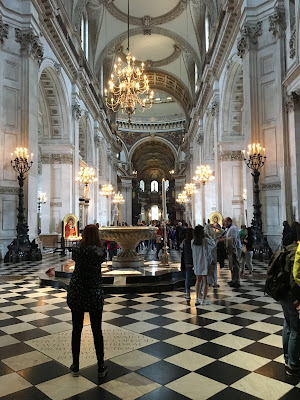How can anyone write anything new about St Paul's? A
national symbol and ancient and present religious
centre of the City of London. The Great Fire of London of 1666 destroyed the
old Medieval cathedral beyond repair. It had been the largest in the country,
but with some curious additions, like the 17th century classical west portal by
Inigo Jones. The story of how we got Sir Christopher Wren's masterpiece can be read elsewhere. Thankfully it survived
the Second World War virtually unscathed and is the place for national
celebration ( Prince Charles and Princess Diana wedding 1981 ; Queen Victoria
Diamond Jubilee 1897 and Queen Elizabeth II Golden 2002, Diamond 2012)and
memorial (Funeral for Nelson 1806 Churchill 1965) Enough said : now I am going to restrict myself to personal
observations gained over the years since my first schoolboy visit.
Used to medieval cathedrals I entered this huge monumental
monster - so wide, so magnificent and yet somehow cold and intimidating. I had heard
about the Whispering Gallery (259 steps) but not the miracle of the
construction of that dome within a dome. The paintings in the dome by Thornhill
did not mean much either. I remember climbing up the dome. Another occasion I
even reached the ball at the top - superb view of course but in those days
there was the horror of the neighbouring Paternoster Square. Each time I
visited I felt the similarly intimidated I think.
Next memories are of attending concerts here. Berlioz
Requiem in 1969 (the centenary year of death of one of my heroes) which suited
the building. Bach b minor Mass which I heard about 3 times the same night
because of the 9 second echo! Haydn's Nelson Mass sung during Eucharist one
Sunday was powerful but like an out of focus photo. The organ is huge with
pipes in the original choir screen, in the dome and the triforium. I have yet
to hear the huge chamade trumpets high above the west door. Apparently when the
Queen and Prince Philip first heard them, he muttered "what the b.....
hell is that?" and the Queen doesn't like them either and brings her own
Kneller Hall trumpeters. I can't wait to hear these pipes! You can listen to it in the video below.
I keep promising myself to pay the massive entry fee and
have a good look - see everything. Then
this month I was lucky enough to have a sponsored tour by an experienced guide.
Those great west doors, usually closed, when swung open (effortlessly because
of modern technology) would be magic. We saw the famous circular staircase in
the southwest tower from 1705. We saw
the Chapel of St Michael and St George.
 |
| St George and St Michael Chapel |
 |
| The famous staircase in the southeast tower which leads up to the library |
The paintings in the dome, the idea of which Wren
disapproved, are by Sir John Thornhill
(the only living British painter capable of doing it?). The mosaics around the
dome and over the choir are Victorian. I deduce that the original effect would
have been plainer, more classical, more Palladian. That brings me to the
question of whether St Paul's Baroque at all and instead more a Classical or Renaissance building. Hours
could be spent debating this. The truth is that it is a synthesis of different
styles (medieval, classical and baroque) pulled together by a mastermind, and
having to accomodate differing
obligations.
 |
| Dome into the choir : choir screen originally blocked this off |
Originally the choir was separated off by the choir screen ;
the magnificent wooden choir stalls are 17th century. The Victorians wanted a
view straight down the nave through to the choir so the screen and organ were
removed in 1860. A Victorian marble reredos was lost in 1940 and the more Baroque present altar and
baldacchino were consecrated in 1958.
 |
| Victorian mosaics |
 |
| Choir and baldacchino |
300 monuments crowd the building in nave and crypt with
Wellington and Nelson most prominent ; none are part of my story. For me it is
the simple plaque and place of burial for the 91 year old Sir Christopher Wren
in the crypt with the Latin inscription put there by his son " Reader, if you seek a monument, look
around you."
 |
| Wren's grave and memorial |


No comments:
Post a Comment